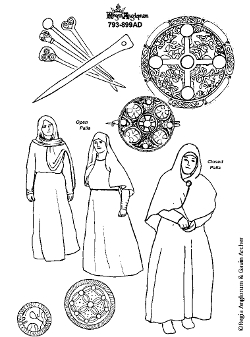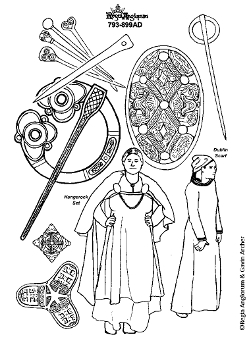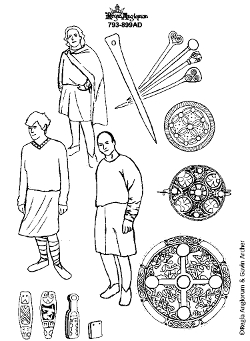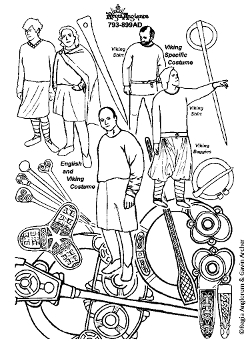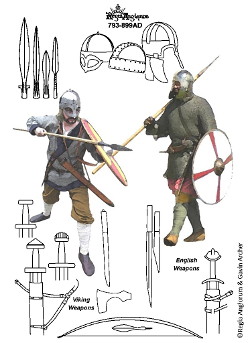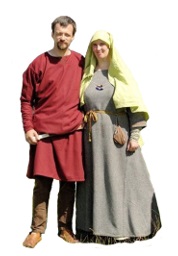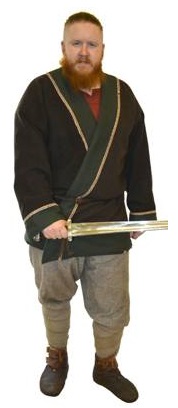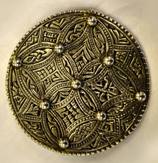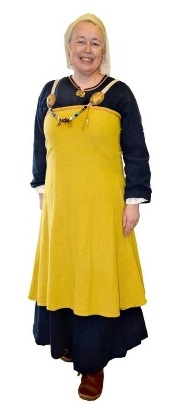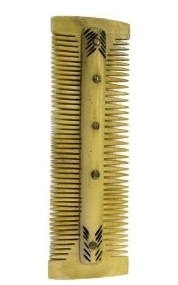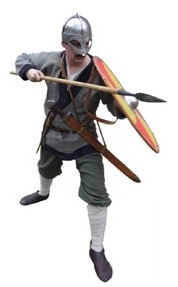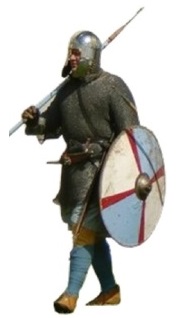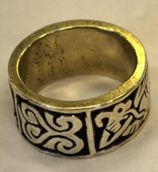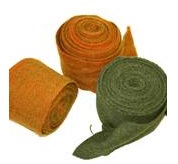Authenticity Officer’s Photo Guide – Examples of Authentic Kit
The Examples of Authentic Kit is a gallery of good examples of authentic kit, and can be used by members as a guide for what to aspire to. However, it is also an open competition amongst the membership, where they can submit photographs of themselves in kit – with examples of the most authentic kit being shown here.
All Periods
All Periods793 - 899
793 - 899900 - 979
900 - 979980 - 1041
980 - 10411042 - 1079
1042 - 10791080 - 1179
1080 - 11791180 - 1215
1180 - 1215Viking invasion and settlement. King Alfred and the Danelaw.
In the 9th century women wear the open palla. This is a large, light-weight rectangle of cloth worn draped over the head and shoulders. It was worn loose and open or else closed, clasped at the chest with a brooch. An alternative head-covering is the simple long scarf type veil, popular in both England and in Carolingian Europe, and worn loosely draped over the head and wrapped around the shoulders whilst leaving the neck showing.
The dresses are simple, ankle length and with tight sleeves to the wrist. Neck-holes are either round or oval, and can have a keyhole opening. Decoration, in the form of facings, embroidery or tablet weave, can be applied to the cuffs and neck-hole. Tied belts of simple braid or cloth, sometimes ending in twin delicate silver strap ends, can be worn, but never belts of leather.
For warmth a cloak can be worn, clasped at the chest by a large disc brooch of silver or copper alloy. Poorer women would close their cloak with ties, a pin of bone, iron or copper-alloy.
Shoes are of the simple, two-part turn shoe construction and are usually low, coming to below the ankle.
Silver is commonly used for jewellery. Art styles still follow the Germanic preference for intertwined stylistic beasts like the Trewhiddle style.
Most Viking women who settled in Britain were pagan and wore distinctive pagan clothing. They tended to very quickly adopt or adapt to local fashions, incorporating them into their style of dress.
Hair is usually long and braided, left bare or else covered with a small cap or scarf. The dresses are simple, ankle length and with sleeves to the wrist. Neck-holes are either round or oval, and can have a keyhole opening. Decoration usually in the form of facings, narrow silk strips and tablet weave can be applied to the cuffs and around the neck-hole. Vikings don't seem to have favoured embroidery although embroidered panels were imported from other countries. Dresses are usually made from wool but can also be from linen.
Over the dress middle-class women can wear a Hangerock. This is a strapped sleeveless dress suspended from a pair of oval brooches. Between the brooches a single string of glass beads was sometimes suspended.
For warmth a cloak can be worn, clasped at the chest by a large disc, trefoil or equal-armed brooch. For middle-class women an alternative is the backtrain. This is a narrow pleated cloak suspended from the oval brooches. Finally some women may have worn a long open fronted coat, closed by a single brooch.
Shoes are of the simple, two-part turn shoe construction and are usually low, coming to below the ankle. Some rich Viking women may have worn low leather boots following the Carolingian fashion.
Silver and copper-alloy are commonly used for jewellery. Art styles still follow the Germanic preference for intertwined stylistic beasts like the Oseberg and Borre styles.
The primary garment is the tunic. Its skirt comes to the knee cap or just above and the sleeves are always worn tight to the forearm and wrist. Neck-holes are either round, oval or v-shaped, and can have a keyhole opening. Decoration, in the form of facings, embroidery or tablet weave, can be applied to the cuffs and neck-hole but not around the hem of the skirt. Tunics are usually made from wool but can also be from linen.
Belts can be made from either braided wool or a leather strap. They can be simply tied or else closed by a buckle of bone, iron or copper-alloy. Belts often have strap-ends attached. A fashion for tied cloth belts with twin matching silver strap-ends is popular.
For warmth a cloak can be worn, clasped on the right-hand shoulder by ties or a large disc brooch or pin.
Leg coverings, if worn at all, should be tight to the leg and can be trousers or hose and braies. Leg wraps can also be worn. These are long strips of 10cm wide woollen cloth worn wound about the lower leg from the ankle to the knee.
Shoes are of the simple, two-part turn shoe construction and are usually low, coming to below the ankle.
Silver is commonly used for jewellery. Art styles still follow the Germanic preference for intertwined stylistic beasts like the Trewhiddle style.
Viking men’s fashion of the 9th century varies little from that of the English. The main item of clothing is the knee length tunic and other than decorative fashion and jewellery it would be hard to tell a Viking from an Englishman. Neck-holes are either round, oval or v-shaped, and can have a keyhole opening. Decoration usually in the form of facings narrow silk strips and tablet weave can be applied to the cuffs and around the neck-hole. Vikings don't seem to have favoured embroidery although embroidered panels were imported from other countries.
Belts can be made from either braided wool or from a leather strap. They can be simply tied or else closed by a buckle of bone, iron or copper-alloy. Belts often have strap-ends attached.
For warmth a cloak can be worn, clasped on the right-hand shoulder by ties or a large pin or penannular. Viking men do not wear disc brooches.
Leg coverings, if worn at all, are usually trousers. The southern-European fashion for hose and braies is starting to be adopted, possibly by Christians. Leg bindings can also be worn. These are long strips of 10cm wide woollen cloth worn wound about the lower leg from the ankle to the knee.
There are however a few distinctive garments only worn by pagan Vikings. These include wearing just a shirt tucked into trousers and no tunic; baggie trousers, gathered at the knee; and the Viking wrap around warrior coat. These distinctive pagan garments would be accompanied with the appropriate Viking jewellery, mainly a pin or penannular, and Viking style decoration.
Men tend to wear little artistic jewellery, instead mainly wearing simple decorated pins or penannulars. Ring money is worn in the shape of twisted silver neck torcs and arm rings.
A spear is the primary weapon for all warriors, grasped in one hand and used over-arm. A large wooden round shield is the primary form of defence, faced in leather or cloth and with an iron boss covering the centre grip. Additional weapons could include a seax, a large single edged knife; a hand axe, with or without a beard; a langseax, a 45-60cm long single edged knife; or if they are very lucky, a sword. Swords are incredibly expensive and normally only carried by the rich aristocratic warrior class. The seax was carried by the English, both as a status symbol and as a weapon of last resort.
Rich aristocratic warriors are generally better armed and protected. On their head they can wear a domed iron helmet, with a spectacle face plate if they are Vikings. The conical helm is known in mainland Europe and would be classed at the time as ‘cutting edge’ technology. For added protection and as a status symbol, a ‘byrnie’ style of mail shirt is sometimes worn, with or without padding underneath.
Warriors fight on foot and as one unit. Combat starts with exchanges of arrows, javelins and clubs. There are no specific units of 'Archers'. The two shield walls would then advance and engage with spear and shield. Many spears carry pennons and each lord would have with him a banner-man to carry his personal standard.
The woman is wearing an open palla whilst the man wears a simple madder dyed tunic and carries a seax.
Richard and LizWearing a military lined and decorated wrap-around jacket, pinned at the hip by a ringed pin. These 'warrior jackets' are adopted from the mounted warriors from Eastern Europe. He carries a single-edged sword, typical of Norwegian Vikings.
DaveA large silver brooch worn by both English men and women and decorated in the Trewhiddle art style.
by Roland WilliamsonShe is wearing a yellow hangerock with type P37 oval brooches, gilded in gold. For warmth she has a long coat, closed by a single trefoil brooch and her hair is gathered up and covered with a simple cap.
CatherineHe wears distinctive Frisian fashion, a 'pill box' hat, buckled leather garter straps and a 'pallia fresonica' or Frisian cloak.
GaryUsed in England, France, Frisia and Germany. Made of Red deer antler and fixed with iron rivets.
by Roland WilliamsonViking warrior in a spectacle helm and warrior coat. He has a Petersen type 'C' sword and a leaf shaped spear.
MikeA rich English warrior wearing a Coppergate style helmet and a mail shirt. He is armed with a sword, seax and spear and carries a lenticular shaped shield.
PaulA silver finger ring with Trewhiddle style decoration and black niello.
by Roland Williamson